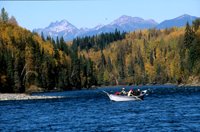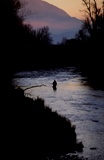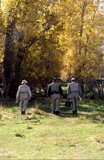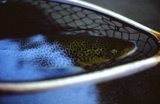Outside of a number of distractions that kept me from fishing, there is a new fly fishing tool that's creeping into the sport that's troubling me. As the year came to a close a particular product has been gaining acceptance, the balloon strike indicator. I got into this business because I have a great passion for the sport. Recent product introductions have me questioning some practices and the lengths we’ll go to catch more fish. The introduction of fluorocarbon tippet and leader materials was the first of these new products that I find ethically questionable. I’ve written about this inert material in the past: Fluorocarbon and Lead: Environmental considerations and concerns. The balloon strike indicator is another that pushes my button.
This crutch and others similar to them have crept into our shops, vests and arsenal of fly fishing apparatuses. The balloon, literally, happens to be the latest handicap we now attach to the end of our line. Guides, not all of course, have driven this trend hoping their clients only care about the number of fish caught irrespective of the techniques employed.
Earlier in the year I witnessed these indicators being used for the first time. A local guide with two very new anglers had each rigged with them. He’d positioned his clients not too far apart, making it all that much easier to instruct both on the finer points of lopping line. Last time I checked fly casting involved a loop of some distinction. With such devises attached to their line these two naive anglers had very little chance of making anything that would resemble a fly cast.
To my recollection, since 1496 when Dame Julian Berners wrote the first book of fly fishing, the challenge of fishing with a fly has been its lure. Bobbers were invented some time ago to aid in a conventional cast when using bait. I thought we left these conventional techniques behind for an esthetically more pleasing and challenging means of catching trout, salmon or steelhead. I guess not. Fishing a fly behind a bubble cast from a conventional fishing rod and reel is not fly fishing. Fishing with a bobber attached to your fly line isn’t either. Think about it! Or possibly for the sake of adding one or two more fish to your daily total, we’ll ignore such cogitations. Those who came before us and laid the groundwork for this challenging sport went to great lengths to pass on their legacies; Marinaro, Wulff, LaBranche, Skues arguably they are rolling in their graves.
In May an issue arose that involved the Green River; SITLA’s willingness to sell a critical piece of land smack dab in the middle of the corridor. It just so happens that it’s the only parcel with the potential for being developed. If Brett Prettyman hadn’t written a follow-up article in the Salt Lake Tribune reporting the progress of this project it would have been consummated long ago. His piece sparked a furious retort by anglers nation wide forcing SITLA to ponder its direction. That pause allowed dedicated anglers, Rich Seamons in particular along with members from the Stonefly Society, time to participate in the process. Earlier I’d dedicated several Blog’s on the progress and process as it unfolded. Unfortunately it's the process is still lingering.
What bothers me is SITLA’s lack of principle given the sensitive nature of this land. They claim their mandate forces their hand in such matters. Under similar circumstances they’ve made exceptions in the past. They even state such in their brochure. SITLA knew that this transaction would be met with great controversy, however I don’t think they were fully aware of the extent of the opposition. They know it now.
For years The DWR (Division of Wildlife Resources) has communicated with SITLA their desire to acquire this critical parcel. They, SITLA, had options before them that involved the DWR that would allow them to satisfy their mandate, yet preserve this unique parcel. Speculatively they didn’t.
In fairness, to SITLA, the Division dropped a ball or two in the process as well. The Division has access to sufficient funds to secure this parcel, yet they choose not to exercise or entertain such financial options for fear they will set a precedence. Others viably argue given the unique nature of this parcel that there is no precedence. After all we are talking about one of the nations most valuable resources. Not to mention it’s also one of Utah’s.
Adding insult to injury, the legislature recently announced that it is willing to free up 20 million dollars to aid in the purchase of another controversial SITLA parcel, Tabby Mountain. All we needed was a few million, which we begged for. We spent a concerted effort trying to get Gov. Huntsman to support the angler’s efforts. Although we met in his office, he refused to personally engage himself.
At this juncture, the angling community remains involved but increasingly frustrated. It appears that an access issue is the only leg we have to stand on at this point. That issue, thanks to the DWR, remains key in any further transactions. Should SITLA not be able to clarify this, they won’t be able to receive fair market value for the parcel. If such is fact, there is a possibility the parcel will be taken from the auction block lending some room for optimism. At this juncture we can only hope.
While whining I have to throw the ugly giant that moved down the street into the fuss. Disneyland (Cabelas) came to town this past year. That’s not news to anyone in this part of the country. We felt their impact before they finished building their store and it wasn't the tax incentives and other sweet offering they received. It started when they took one of our key employees, Ryan Barnes. They were able to take him from us because of all the sweet deals local and county officials poured upon them for locating here. We weren’t the only ones they impacted in this manner.
It’s taken us eight months to get our feet under us after their opening. We weren’t sure we ever would. Their presence and long term impact still raises grave concerns. Our ability to keep our head above ground comes with a significant amount of gratitude from loyal patrons who stuck with us during their initial dog and pony show. Now that the wave has subsided, we appear to be back to normal. To those who didn't succumb, thank you.
If establishments like these are to be our resources for fly fishing products, I’d give up the sport. The Big Box revolution seems to be taking a strangle hold on this country and with it many small good retailers are going out of business. By the success of our year most of you share my sentiments and recognize the contributions and niche specialty fishing services brings to your sport. Cabelas and the likes have little interest in stewardship issues when it comes to our local resources and our sport. Since being publicly traded, the sales of their Cabelas brand products and their bottom line is foremost on their minds.
Enough venting. In many ways it was the most trying year I’ve experienced, but it also bore some great rewards. I did get out and fish some this year, but many of the elements that I’ve just ranted about kept me from wetting a line as much as I would of liked. That’s standard for 99% of us who fish. We all have our excuses. I know of only a few who cast a fly as frequently as they would like. My hat goes off to them.
Looking back, fishing provided my salvation and lent a bit of sanity to my year. It always does. With winter's severe cold I’m reduced to living vicariously through the latest versions of fish porn. I’d have to say that the latest viewings are pretty darn good. If you are into the new DVD's and your should be, make sure to check out "Running Down the Man" and "Trout Bum, Diaries, Volume II" They are soon to be released. If they are anything like the teasers we've been viewing, we are in for a treat. Nothing like the real thing however. As it’s been said “the tug is the drug” and if such be the case I’m a hopeless addict.
















